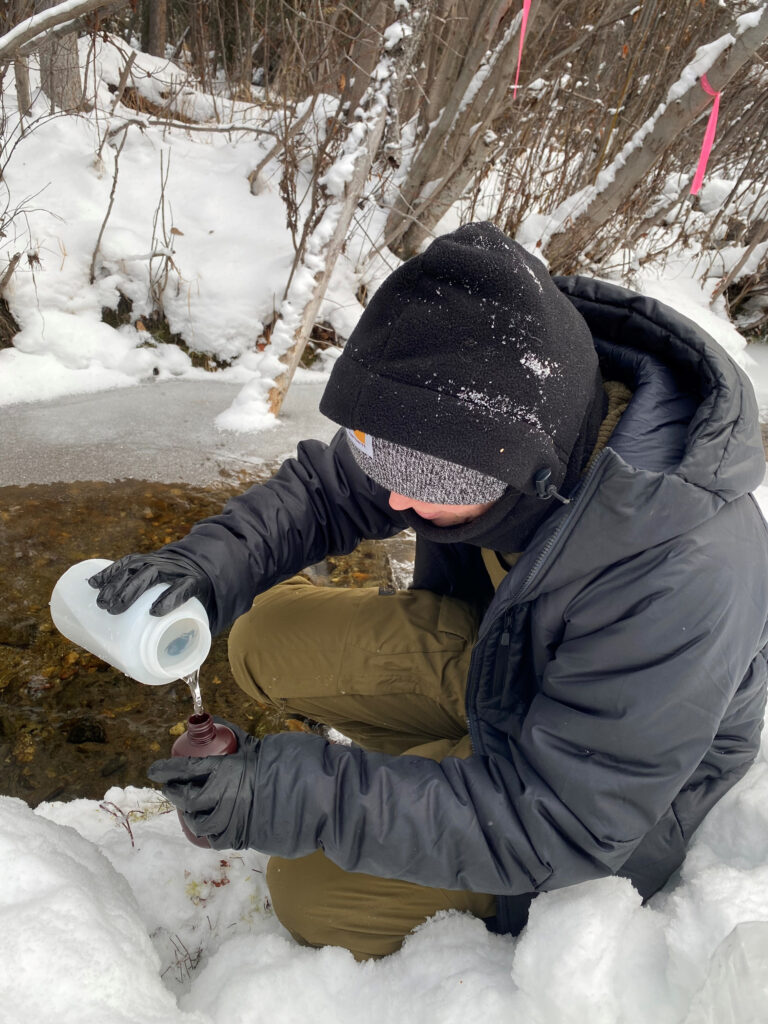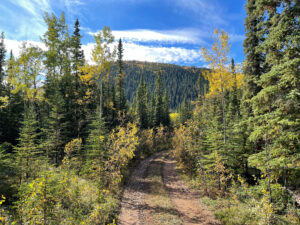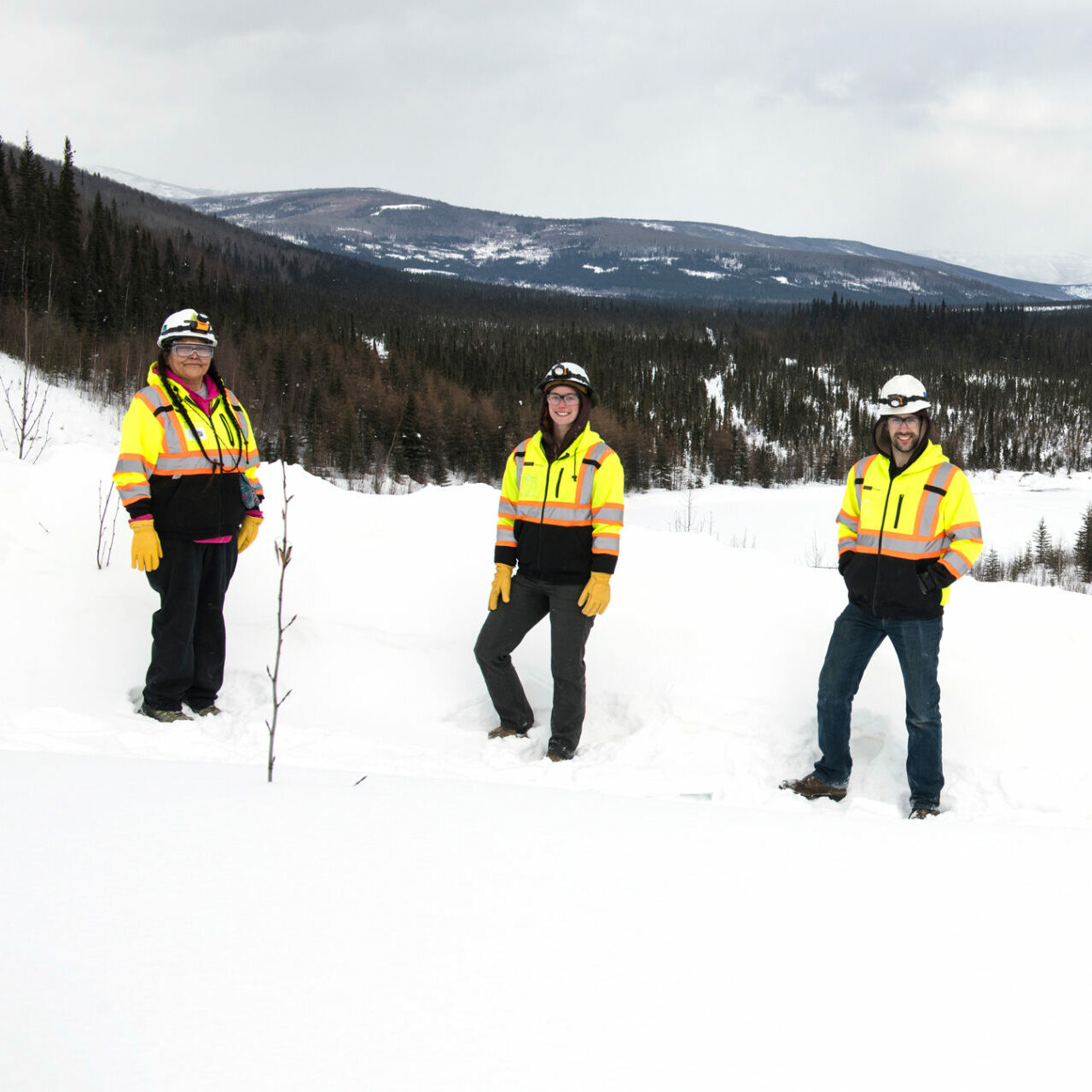Trucking Facts
Safety Features
The purpose-built trucks will be the safest on the road, equipped with:
- ANTI-LOCK DISC BRAKE SYSTEM
- SPEED MONITORS
- FATIGUE MONITORING
- DRIVER ASSISTANCE DEVICES
There will be real time communication between drivers and dispatch to alert drivers about conditions and potential hazards.
Truck Traffic
Trucks will operate 24 hours a day.
On average:
60 ROUND TRIPS per day,
2.5 TRIPS per hour when conditions allow.
Traffic volumes will increase traffic by 5-20% in remote locations and less than 1% in the Fairbanks area. The trucks drive to conditions, including slowing or stopping operations as required.
Highway Improvements
The state is planning improvements along the transportation route, including updating and adding passing lanes, asphalt resurfacing and other work.
5 BRIDGES are scheduled for replacement, including two that date back to 1944.
Funding primarily comes from the 2021 federal Infrastructure Investment & Jobs Act.
Trucking Contractor
Black Gold Transport (BGT), a division of Black Gold Express, is based in North Pole and has served Alaska since 1987. Their safety record is outstanding. They have a comprehensive safety management system, with vehicle and driver monitoring, and an extensive, proven driver training program anchored by a rigorous behind-the-wheels training component.
Highway Wear and Tear
These trucks carry legal loads that do not require any special permits or exemptions. Total vehicle length is 95’, similar to double fuel and double cargo trailers used in Alaska today, with a payload of about 50 tons and a total gross vehicle weight of 82.5 tons per vehicle. Engineers at the trailer manufacturing company suggested a change to 16 axles and 36 tires with a wider tread. This change decreases the chance of debris getting caught in the tires. An optimization to the trailer design has reduced the number of trips per day by 10%.
BGT has also invested in separate tires for winter and summer use to ensure top notch safety.
Environmental Facts
Permitting
Manh Choh has undergone a rigorous, multi-year process to obtain the permits it needs to operate. At the federal level, Section 404 of the Clean Water Act requires that the U.S. Corps of Engineers, in consultation with other agencies, issue a permit before dredged or fill material can be discharged into waters of the United States, including wetlands. Depending on the complexity of a project, the Corps and other agencies require that either an Environmental Assessment (EA) or an Environmental Impact Statement (EIS) be conducted by an independent contractor to help them reach a decision. Following a prescribed public process that involved a public comment period, the Corps determined that an EA was sufficient to understand the human and environmental impacts of the mine and issued the permit.
A similar effort at the state level involved the Alaska Department of Natural Resources which issued permits for the Reclamation Plan and the Department of Environmental Conservation which issued the permit for Waste Management. Both processes included a formal public notification process that included a 32-day public comment period. Like all mines in Alaska, the state required Manh Choh operators to post a financial assurance bond ($63.5 million) and will require an independent, third-party environmental audit before closure to verify compliance with all applicable environmental laws.
Information about these permits is posted on the state website, Alaska Department of Natural Resources, Large Mines Program.
Manh Choh’s Required Permits, Plans & Approvals
- State Historic Preservation Office Memorandum of Agreement
- Fish Habitat Permit FH22-III-0019
- Fish Habitat Permit FH22-III-0166
- Fish Habitat Permit FH22-III-0172
- Manh Choh Minor Permit AQ1616MSS01
- Clean Water Act 404 Wetlands Fill Permit
- POA-2013-00286
- Clean Water Action 401 Water Quality Certification
- POA-2013-00286 v1.0
- APMA 2626
- Temporary Water Use Authorization TWUA F022-032
- Temporary Water Use Authorization TWUA F022-101
- Temporary Water Use Authorization TWUA F022-102
- Tetlin Storm Water Permit & SWPPP
- Permittee Responsible Mitigation Plan
- Solid Waste Management Plan
- Waste Management Permit 2023DB0001
- Water Management Plan
- Support Document for Waste Management Permit and Plan of Operations
- Reclamation Plan Approval F20232323RPA
- Monitoring Plan
- Fuel Island Review 2023AFM0006
REGULATORY BODIES
- U.S. Army Corps of Engineers
- State of Alaska
- Alaska Department of Environmental Conservation
Noise Levels
The trucks increased noise levels along the transportation route by 7 to 8 decibels (dBA). This slight increase keeps noise levels below 58 dBA, which is 8 dB less than the traffic noise limits set by the Federal Highway Administration and Alaska Department of Transportation and Public Facilities. By comparison, a human conversation is between 60-70 dBA.

Air Quality
The new trucks have high-efficiency, low-emission engines that meet the latest EPA 2021 (Tier 4 comparable) emissions standard and burn ultra-low-sulfur diesel. Independent modeling shows trucking contributes less than 0.25% of PM 2.5 emissions in the Non-Attainment Area 1. The full report is posted at manhchoh.com.
Potentially Acid Generating (PAG) Rock

Some of the rock at Manh Choh contains natural minerals, which could oxidize naturally over time (minimum 5 years) through exposure to air and water together. Other rock at Manh Choh contains minimum carbonates that neutralize the PAG rock. The waste rock is stored at Manh Choh and disposed of it at mine closure by returning it to the main pit and covering it. Any PAG tailings at Fort Knox will be submerged at the bottom of the oldest, mined-out part of the Fort Knox pit where the natural water table will be allowed to flood the tailings and keep any sulfide tailings from oxidizing. Kinross Alaska submitted a robust plan to the state for safely handling PAG materials. These plans are detailed in documents posted on the state website under Large Mine Programs, Alaska Department of Natural Resources.
Dust Control
The trucks carry rocks, not metal concentrates. There is minimal dust associated with Manh Choh transportation and the loads are fully covered and secured.
Community Outreach
- The Manh Choh permits have been discussed at over 100+ community meetings and updates since 2021.
- The project team has met with all school districts and bus providers along the transportation route.
- The Manh Choh team meets regularly with communities along the corridor and surrounding villages.
Social/Economic Facts
Economic impact
A socioeconomic assessment of economic impacts done by McKinley Research in 2021 found the mine will have a significant, positive impact on the region:
Summary of Manh Choh Project Potential Annual Economic Benefits:
Economic Activity Annual Impacts
Construction Phase Impacts
(2022-2023)
280 – Average monthly employment
205 – Indirect and induced employment in Alaska
485 – Total Alaska employment
(direct, indirect and induced)
Mine Operations Phase Impacts
(2024-2028)
500 – Average monthly employment
450 – Indirect and induced employment in Alaska
950 – Total Alaska employment
(direct, indirect and induced)
Annual Resident and Non-resident
Payroll Impacts (2022-2023)
$50 M – Total direct payroll (all employees)
$25 M – Indirect and induced payroll in Alaska
$75 M – Total annual resident and nonresident payroll
(direct, indirect and induced)
You can view entire report here
Construction Phase Impacts
(2024-2028)
$75 M – Annual direct payroll
$45 M – Indirect and induced payroll in Alaska
$120 M – Total Alaska payroll
(direct, indirect and induced)
4.5 YRS Estimated mine life
Other Impacts
Manh Choh will purchase an estimated $425 million in goods and services from local businesses in Tok, Delta Junction, Fairbanks and other locations.
- The average wage is estimated to be $128,230 (not including benefits). Many employees will undergo job training that will give them employable skills for a lifetime.
- Reclamation is estimated at $40-60 million. The project has posted a $63.5 million reclamation assurance bond with the state.
The mine helps keep the mill at Fort Knox going, which means the Fairbanks North Star Borough will continue to collect property tax, 700 locals will continue to work at the mine and Fort Knox will continue to pay state taxes.
Tok Campus
Many workers – including drivers – live in Fairbanks and the communities surrounding the mine and commute to their jobs. Others stay at the Tok Campus. This is a locked 175-room facility with zero tolerance for alcohol and drugs. No guests are permitted to stay overnight.

Workforce Development
Kinross and its business partners are committed to local hire and Kinross has sponsored workshops, on-the-job training and job fairs to help area residents prepare for Manh Choh jobs. Kinross helps youth develop work skills for a lifetime by endowing scholarships like the new Future Leaders at UAF, computers for Tetlin high school graduates and sponsorship of students to EXCEL, a program dedicated to improving education outcomes in rural Alaska. Additionally, the Alaska Department of Labor and Workforce Development provided a $300,000 grant to UAS’ Mining and Training Petroleum Service program to train area residents for the mining jobs.